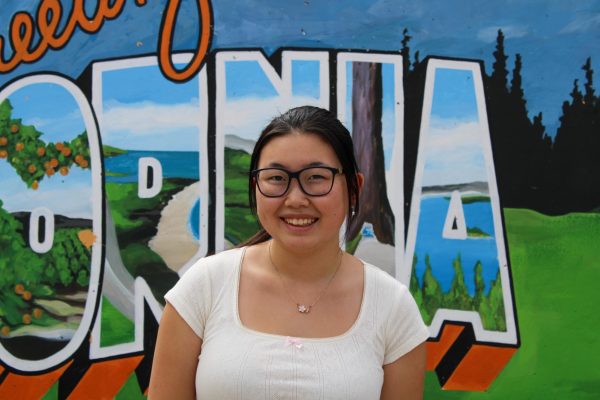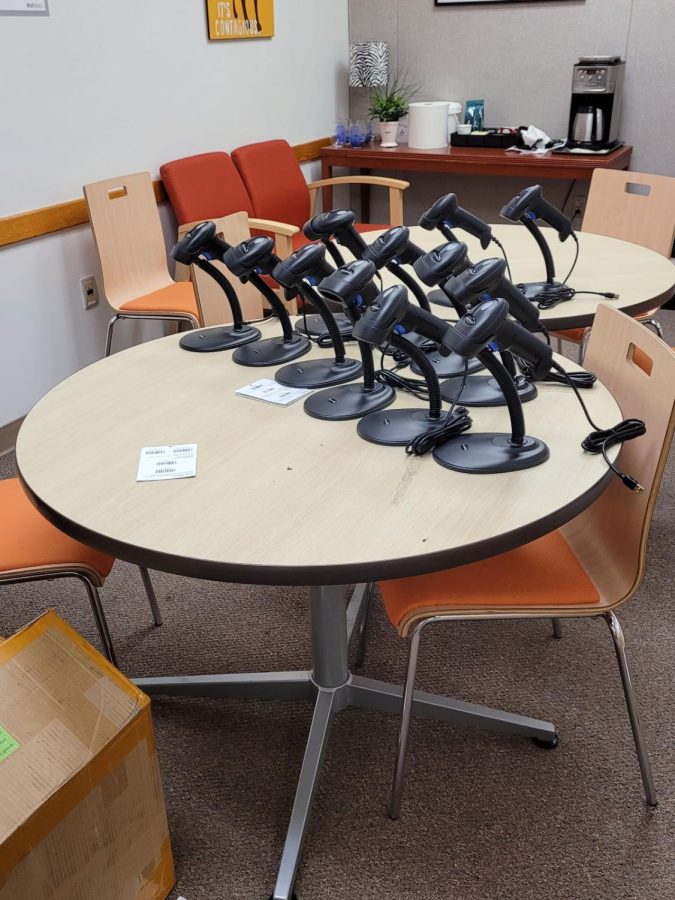New attendance scanners have mixed results
Technology causes confusion as students adjust
Photo courtesy of Cal High administration
Scanners accompanied by designated computers have been installed in classrooms for students to use to check into class.
Cal High’s new ID scanners were implemented in October with the purpose of streamlining the attendance system.
But they have created attendance errors, false tardies and other issues as students and teachers try to adapt to them.
Students are now required to scan their ID cards with the new scanners or type their ID numbers to be marked present in class and student support.
The scanner system was first implemented at San Ramon Valley High School in February and later at Monte Vista High School. Chad Cochran San Ramon Valley teacher on special assignment (TSA) said the scanning system has made attendance fast and easy there.
“It’s quick, and as long as everything is set up then it is really accurate,” said Cochran, a technology TSA . “I know the attendance office is really happy about it.”
But Cal attendance secretary Anjali Gahlot said the school has not experienced the same benefits so far. Gahlot said attendance secretaries have to manually change attendance mistakes and make more calls to parents about students being marked absent when they were actually in class.
“[The scanners are] causing more [human] errors than usual,” Gahlot said. “I feel like the teachers are still getting used to the scanners and the students are not trained.”
Assistant principals Azine Davoudzadeh and Jeff Osborn, who contributed to the implementation of the scanners, said the intention of the system was to decrease human error and increase efficiency in the new attendance system.
“In a perfect world, everyone is participating in the attendance process,” Davoudzadeh said. “However, we noticed due to human error there were discrepancies in the attendance which resulted in students’ parents being called and the arduous clearing of the absence process increasing.”
Davoudzadeh said the decision to change the attendance system was made after speaking with a number of people in the community, including teachers.
Though this system was implemented to help decrease the errors that occur during attendance, some students find the new strategy unhelpful.
“I like [scanners] but I feel like sometimes if I forget to do it I’m going to get marked absent and I don’t want to do that,” sophomore Lauren Guerrero said.
Added junior Rookia Alam, “Personally, I don’t think this is a system that needs to be implemented in every classroom. [The scanners] cause unnecessary tardies since some teachers open the door when the bell rings, so the long line makes a lot of people late [for class].”
On the other hand, senior Andrew Xiong said he feels more positively about the scanners compared to some of his classmates.
“I get that the school is trying to prevent students from leaving the class, but it’s hard to adjust to [the scanners],” Xiong said.
Senior Ian Jensen agrees.
“Honestly [the scanners] are not that bad. I don’t think it’s that much of a hassle,” Jensen said. “Although I think it’s very easy for someone to fake their presence.”
But freshman Ethan Larson feels the new system is unnecessary.
“Most teachers just do the regular attendance anyway, and they don’t even look at the ID scanners,” Larson said. “My math teacher uses a pen and paper even now.”
Teachers are also split about how much scanners are helping.
“I don’t mind [the scanners] at all. I think it’s totally fine now that I know how to use it,” English teacher Chloe Elliott said. “I feel like it’s pretty easy.”
Principal Demetrius Ball believes the system will become more streamlined as students and staff adjust to the change.
“I think the teachers and the students are both going to get more used to the system, making sure that everyone has their ID cards and go and scan,” Ball said. “With any type of technology, there’s going to be hiccups and challenges.”
But Gahlot feels that adjusting may take longer.
“It doesn’t seem like things are going to improve. It’s already been two months [since the scanner system started],” Gahlot said.
Davoudzadeh said the idea for the scanners first came about when staff and the San Ramon Valley Unified School District Board of Education realized that if they could automate the attendance system, then teachers wouldn’t have to spend class time taking roll.
They believed it would provide more time for teachers to build better relationships with their students and focus on teaching.
Davoudzadeh said the scanners also will save students from embarrassment when it comes to teachers pronouncing their name incorrectly. She said that she was a student whose name was mispronounced as well, so she understands how uncomfortable it makes some students feel.
The new attendance system can also help LGBTQIA+ students, said Davoudzadeh. The system can help students that do not want to be dead named (calling a trans person by their birth name when they have changed it) or referred to with incorrect pronouns.
The most significant advantage to the scanners for administrators is that it works well with Responsive Scheduler, a student support website used to track and monitor students’ shift in classes during tutorial. The district uses it in Infinite Campus and it is one of the many ways that attendance is recorded during tutorial.
“Students will eventually be able to make choices of where they want to attend for tutorial or be requested by teachers, which will better serve their academic and social emotional needs,” Davoudzadeh said.
The school is still in the process of getting its scanners to work during tutorial with the Responsive Scheduler program. Currently, students scan in their third and fourth-period classes whether they stay there or move to another classroom for tutorial.
Davoudzadeh said she understands not everyone is comfortable with the scanners yet, and is giving it time so that everyone can adjust. She appreciates any feedback regarding the system so the school board and administrators can iron out all the wrinkles.
Osborn is also on board when it comes to feedback from the students and wants to help make the system even better.
“I’m seeking feedback from the students so that I can help them utilize their time to the best of their ability,” Osborn said.

Junior Vedant Desikamani is back for his third year with The Californian. This is his second year as an editor. He worked as an Assistant News Editor last...

Senior Ylin Zhu is back for her fourth and final year with The Californian Paper and this year as Editor-in-Chief. After pouring her blood sweat and tears...










